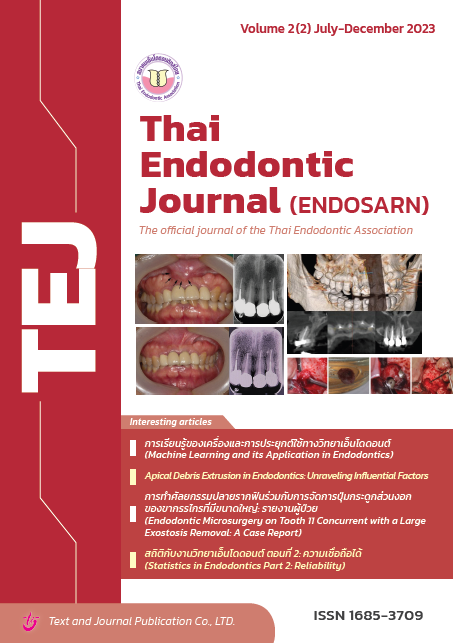Apical Debris Extrusion in Endodontics: Unraveling Influential Factors
Keywords:
apical debris extrusion, chemical-mechanical preparation, root canal treatmentAbstract
Debris generated primarily during chemical-mechanical root canal preparation is composed of dentine fragments, residual dental pulp remnants, microorganisms, and irrigants. The unintended extrusion of this debris toward the periapical region gives rise to postoperative pain or flare up, which can significantly impact the patient's quality of life. Furthermore, in certain scenarios, the apical extrusion of debris can foster the development of extraradicular infections. In this review, we provide a comprehensive overview of apical debris extrusion, with a specific focus on the determinants influencing this phenomenon. Notably, the curvature of the root canal, an inherent property of the tooth itself, is a pivotal factor that exerts a discernible influence on the apical debris extrusion. Additionally, other procedural elements during root canal treatment, such as the access cavity, the working length determination, the mechanical instrumentation process, and the root canal irrigation method, play crucial roles in modulating the amount of apical debris extrusion.
References
Huang X, Ling J, Wei X, Gu L. Quantitative evaluation of debris extruded apically by using ProTaper Universal Tulsa rotary system in endodontic retreatment. J Endod. 2007;33(9):1102-5.
Siqueira JF, Jr. Microbial causes of endodontic flare-ups. Int Endod J. 2003;36(7):453-63.
Karataslioglu E, Arslan H, Er G, Avci E. Influence of canal curvature on the amount of apically extruded debris determined by using three‐dimensional determination method. Australian Endodontic Journal. 2019;45(2):216-24.
Serefoglu B, Kandemir Demirci G, Miçooğulları Kurt S, Kaşıkçı Bilgi İ, Çalışkan MK. Impact of root canal curvature and instrument type on the amount of extruded debris during retreatment. Restorative Dentistry & Endodontics. 2021;46(1).
Karataslioglu E, Arslan H, Er G, Avci E. Influence of canal curvature on the amount of apically extruded debris determined by using three-dimensional determination method. Aust Endod J. 2019;45(2):216-24.
Contreras MA, Zinman EH, Kaplan SK. Comparison of the first file that fits at the apex, before and after early flaring. J Endod. 2001;27(2):113-6.
Constante IG, Davidowicz H, Barletta FB, Moura AA. Location and angulation of curvatures of mesiobucal canals of mandibular molars debrided by three endodontic techniques. Braz Oral Res. 2007;21(1):22-8.
Tufenkci P, Yilmaz K, Adiguzel M. Effects of the endodontic access cavity on apical debris extrusion during root canal preparation using different single-file systems. Restor Dent Endod. 2020;45(3):e33.
Memiş M, Karataş E. The effect of different endodontic access cavity designs on the amount of apically extruded debris. Turkish endod j. 2022;7(1):13-20.
Paqué F, Balmer M, Attin T, Peters OA. Preparation of oval-shaped root canals in mandibular molars using nickel-titanium rotary instruments: a micro-computed tomography study. J Endod. 2010;36(4):703-7.
Myers GL, Montgomery S. A comparison of weights of debris extruded apically by conventional filing and Canal Master techniques. J Endod. 1991;17(6):275-9.
Martin H, Cunningham WT. An evaluation of postoperative pain incidence following endosonic and conventional root canal therapy. Oral Surg Oral Med Oral Pathol Oral Radiol Endod. 1982;54(1):74-6.
Beeson TJ, Hartwell GR, Thornton JD, Gunsolley JC. Comparison of debris extruded apically in straight canals: conventional filing versus profile .04 Taper series 29. J Endod. 1998;24(1):18-22.
Reddy SA, Hicks ML. Apical extrusion of debris using two hand and two rotary instrumentation techniques. J Endod. 1998;24(3):180-3.
de Moura JDM, da Silveira Bueno CE, Fontana CE, Pelegrine RA. Extrusion of debris from curved root canals instrumented up to different working lengths using different reciprocating systems. J Endod. 2019;45(7):930-4.
Silva EJNL, Teixeira JM, Kudsi N, Sassone LM, Krebs RL, Coutinho-Filho TS. Influence of apical preparation size and working length on debris extrusion. Braz Dent J. 2016;27:28-31.
Hawi N, Pedullà E, La Rosa GR, Conte G, Nehme W, Neelakantan P. Influence of Coronal Flaring on the Shaping Ability of Two Heat-Treated Nickel-Titanium Endodontic Files: A Micro-Computed Tomographic Study. J Clin Med [Internet]. 2023; 12(1).
Borges Á H, Pereira TM, Porto AN, de Araújo Estrela CR, Miranda Pedro FL, Aranha AM, et al. The Influence of Cervical Preflaring on the Amount of Apically Extruded Debris after Root Canal Preparation Using Different Instrumentation Systems. J Endod. 2016;42(3):465-9.
Gunes B, Yeter KY. The effect of cervical preflaring on the apical debris extrusion of single or multiple rotary Ni-Ti files. Niger J Clin Pract. 2020;23(4):510-4.
Dagna A, El Abed R, Hussain S, Abu-Tahun IH, Visai L, Bertoglio F, et al. Comparison of apical extrusion of intracanal bacteria by various glide-path establishing systems: an in vitro study. Restor Dent Endod. 2017;42(4):316-23.
Ha JH, Kim SK, Kwak SW, El Abed R, Bae YC, Kim HC. Debris extrusion by glide-path establishing endodontic instruments with different geometries. J Dent Sci. 2016;11(2):136-40.
Gunes B, Yesildal Yeter K. Effects of Different Glide Path Files on Apical Debris Extrusion in Curved Root Canals. J Endod. 2018;44(7):1191-4.
Eshagh Saberi A, Ebrahimipour S, Saberi M. Apical Debris Extrusion with Conventional Rotary and Reciprocating Instruments. Iran Endod J. 2020;15(1):38-43.
Schäfer E, Schulz-Bongert U, Tulus G. Comparison of hand stainless steel and nickel titanium rotary instrumentation: a clinical study. J Endod. 2004;30(6):432-5.
Boijink D, Costa DD, Hoppe CB, Kopper PMP, Grecca FS. Apically Extruded Debris in Curved Root Canals Using the WaveOne Gold Reciprocating and Twisted File Adaptive Systems. J Endod. 2018;44(8):1289-92.
Keskin C, Sariyilmaz E. Apically extruded debris and irrigants during root canal filling material removal using Reciproc Blue, WaveOne Gold, R-Endo and ProTaper Next systems. J Dent Res Dent Clin Dent Prospects. 2018;12(4):272-6.
Imura N, Kato AS, Hata GI, Uemura M, Toda T, Weine F. A comparison of the relative efficacies of four hand and rotary instrumentation techniques during endodontic retreatment. Int Endod J. 2000;33(4):361-6.
Saricam E, Kayaoglu G. Comparison of OneShape, 2Shape and One Curve endodontic instruments for debris and irrigant extrusion. Dent Med Probl. 2020;57(3):255-9.
Al Omari T, El-Farraj H, Arican B, Atav Ates A. Apical debris extrusion of full-sequenced rotary systems in narrow ribbon-shaped canals. Aust Endod J. 2022;48(2):245-50.
Silva EJ, Carapiá MF, Lopes RM, Belladonna FG, Senna PM, Souza EM, et al. Comparison of apically extruded debris after large apical preparations by full-sequence rotary and single-file reciprocating systems. Int Endod J. 2016;49(7):700-5.
Ozsu D, Karatas E, Arslan H, Topcu MC. Quantitative evaluation of apically extruded debris during root canal instrumentation with ProTaper Universal, ProTaper Next, WaveOne, and self-adjusting file systems. Eur J Dent. 2014;8(4):504-8.
Sen OG, Bilgin B, Kocak S, Saglam BC, Kocak MM. Evaluation of Apically Extruded Debris Using Continuous Rotation, Reciprocation, or Adaptive Motion. Braz Dent J. 2018;29(3):245-8.
da Silva E, de Moura SG, de Lima CO, Barbosa AFA, Misael WF, Lacerda M, et al. Shaping ability and apical debris extrusion after root canal preparation with rotary or reciprocating instruments: a micro-CT study. Restor Dent Endod. 2021;46(2):e16.
Solda C, Padoim K, Rigo L, Silva Sousa YTC, Hartmann MSM. Assessment of Apical Extrusion using Rotary and Reciprocating Systems during Root Canal Retreatment. J Contemp Dent Pract. 2020;21(3):238-41.
Mustafa R, Al Omari T, Al-Nasrawi S, Al Fodeh R, Dkmak A, Haider J. Evaluating In Vitro Performance of Novel Nickel-Titanium Rotary System (TruNatomy) Based on Debris Extrusion and Preparation Time from Severely Curved Canals. J Endod. 2021;47(6):976-81.
Costa EL, Sponchiado-Junior EC, Garcia LFR, Marques AAF. Effect of large instrument use on shaping ability and debris extrusion of rotary and reciprocating systems. J Investig Clin Dent. 2018;9(1).
Üstün Y, Çanakçi BC, Dinçer AN, Er O, Düzgün S. Evaluation of apically extruded debris associated with several Ni-Ti systems. Int Endod J. 2015;48(7):701-4.
McKendry DJ. Comparison of balanced forces, endosonic, and step-back filing instrumentation techniques: quantification of extruded apical debris. J Endod. 1990;16(1):24-7.
Predin Djuric N, Van Der Vyver P, Vorster M, Vally ZI. Comparison of apical debris extrusion using clockwise and counter-clockwise single-file reciprocation of rotary and reciprocating systems. Aust Endod J. 2021;47(3):394-400.
Bürklein S, Schäfer E. Apically extruded debris with reciprocating single-file and full-sequence rotary instrumentation systems. J Endod. 2012;38(6):850-2.
Uslu G, Ozyurek T, Yilmaz K, Gundogar M, Plotino G. Apically Extruded Debris during Root Canal Instrumentation with Reciproc Blue, HyFlex EDM, and XP-endo Shaper Nickel-titanium Files. J Endod. 2018;44(5):856-9.
Mustafa R, Al Omari T, Al-Nasrawi S, Al Fodeh R, Dkmak A, Haider J. Evaluating In Vitro Performance of Novel Nickel-Titanium Rotary System (TruNatomy) Based on Debris Extrusion and Preparation Time from Severely Curved Canals. J Endod. 2021;47(6):976-81.
Yılmaz Çırakoglu N, Özbay Y. Apically extruded debris associated with ProTaper Next, ProTaper Gold and TruNatomy systems: An in vitro study. J Dent Res Dent Clin Dent Prospects. 2021;15(1):30-4.
Vande Visse JE, Brilliant JD. Effect of irrigation on the production of extruded material at the root apex during instrumentation. J Endod. 1975;1(7):243-6.
Psimma Z, Boutsioukis C, Kastrinakis E, Vasiliadis L. Effect of needle insertion depth and root canal curvature on irrigant extrusion ex vivo. J Endod. 2013;39(4):521-4.
Azizi Mazreah S, Shirvani A, Azizi Mazreah H, Dianat O. Evaluation of irrigant extrusion following the use of different root canal irrigation techniques: A systematic review and meta-analysis. Aust Endod J. 2022.
Caviedes-Bucheli J, Rios-Osorio N, Rey-Rojas M, Laguna-Rivero F, Azuero-Holguin MM, Diaz LE, et al. Substance P and Calcitonin gene-related peptide expression in human periodontal ligament after root canal preparation with Reciproc Blue, WaveOne Gold, XP EndoShaper and hand files. Int Endod J. 2018;51(12):1358-66.
Bassam S, El-Ahmar R, Salloum S, Ayoub S. Endodontic postoperative flare-up: An update. Saudi Dent J. 2021;33(7):386-94.
L.S P, Rao LN, Shetty A, Hegde MN, Shetty C. Impact on Quality of Life of Patients Treated by Different File Systems for Root Canal Treatment. Journal of Health and Allied Sciences NU. 2021;11(01):35-9.
Iqbal M, Kurtz E, Kohli M. Incidence and factors related to flare-ups in a graduate endodontic programme. Int Endod J. 2009;42(2):99-104.
Ng YL, Mann V, Gulabivala K. A prospective study of the factors affecting outcomes of nonsurgical root canal treatment: part 1: periapical health. Int Endod J. 2011;44(7):583-609.
Ng YL, Mann V, Rahbaran S, Lewsey J, Gulabivala K. Outcome of primary root canal treatment: systematic review of the literature -- Part 2. Influence of clinical factors. Int Endod J. 2008;41(1):6-31.
Ricucci D, Siqueira JF, Lopes WSP, Vieira AR, Rôças IN. Extraradicular Infection as the Cause of Persistent Symptoms: A Case Series. J Endod. 2015;41(2):265-73.
Mehdipour O, Kleier DJ, Averbach RE. Anatomy of sodium hypochlorite accidents. Compend Contin Educ Dent. 2007;28(10):544-6, 8, 50.
Ehrich DG, Brian JD, Jr., Walker WA. Sodium hypochlorite accident: inadvertent injection into the maxillary sinus. J Endod. 1993;19(4):180-2.
Downloads
Published
How to Cite
Issue
Section
License
Copyright (c) 2023 Thai Endodontic Journal

This work is licensed under a Creative Commons Attribution-NonCommercial-NoDerivatives 4.0 International License.
Thai Endod Journal is licensed under a Creative Commons Attribution-NonCommercial-NoDerivatives 4.0 International (CC BY-NC-ND 4.0) license, unless otherwise stated. Please read our Policies in Copyright for more information.






